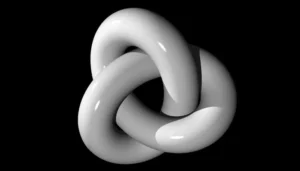With just 54 atoms, scientists have produced the world’s tightest and smallest knot yet documented. This minuscule wonder breaks the previous Guinness World Record and produces a trefoil knot resembling a three-leaf clover. Researchers from the Chinese Academy of Sciences and the University of Western Ontario in Canada worked together to shatter a record of a knot with 69 atoms set in 2020.
Not just the latest achievement has earned a spot in the Guinness Book. In 2019, a human knot with 123 participants was created. A kindergarten class created the biggest Chinese knot in the Guinness Book, which measured more than 130 feet in height and 136 feet in diameter.
Structure
In terms of structure, the world’s tightest and smallest knot wraps around three times without any loose ends. In mathematical knot theory, its structure is significant.
Amazingly, it was stumbled upon by chance. Gold acetylides and phosphine ligands were combined to make different molecular structures known as catenanes. Then, it was found that a portion of the mixture had self-assembled into the world’s tightest and smallest knot. Based on the six gold atoms in it, the world’s tightest and smallest knot can be expressed formulaically as [Au6{1,2-C6H4(OCH2CC)2}3{Ph2P(CH2)4PPh2}3], or simply as Au6.
The backbone crossing ratio (BCR) of the 54-atom knot is 18, which is a considerable improvement over the previous record of 23 for the 69-atom knot. The molecular knot gets tighter and stronger as the BCR decreases. By a BCR margin of 7.3, the new knot is tighter than the BCR of the tightest biological trefoil knots.

The Process
With a lower BCR of 18, the current record holder helps scientists better understand the tiny knots in our bodies’ proteins, RNA, and DNA. This unintentional accomplishment happened while working with metal acetylides necessary for organic chemical processes. When the researchers connected gold acetylide with a diphosphine ligand, they accidentally created a trefoil knot instead of the desired gold chain or catenane.
The accidental creation of the world’s tightest and smallest knot might have wider ramifications. It may help create more sophisticated materials like plastics. The size of the knotted structure determines the properties of valuable molecular materials, such as proteins. The molecular knots can play significant roles in protein structure and function.
Trefoil knots, in particular, are essential to knot theory. It is due to their ability to expand when paired with other knots and tangle with just three crossings. Deciphering the secrets of knots may also have practical uses, such as developing novel chemotherapies or more efficient polymers.



